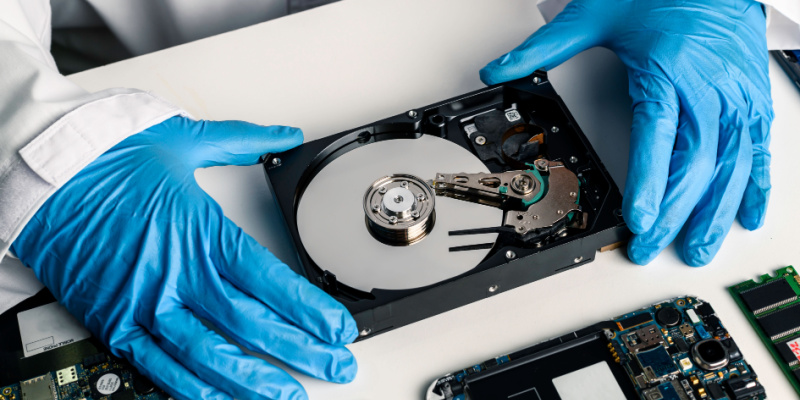In today’s digital age, our lives are increasingly intertwined with technology, making data loss a dreaded reality for many. From precious family photos to crucial work documents, the loss of data can be devastating. But fear not, as the world of data recovery offers a myriad of solutions to retrieve our lost treasures. Join us as we embark on a journey to decode the diverse ways of data recovery, unraveling the mysteries of this essential process.

Understanding the Importance of Data Recovery Techniques
Data recovery techniques play a crucial role in our increasingly digital world, where data loss can have devastating consequences. By understanding the diverse ways in which data can be recovered, individuals and businesses can better protect themselves against potential data disasters. One key aspect of data recovery is the use of backup systems, which create copies of important data to prevent loss in the event of a system failure or cyberattack.
Another important data recovery technique is the use of specialized software designed to retrieve lost or corrupted data from storage devices. These software tools employ algorithms and scanning techniques to locate and restore missing files, helping users recover valuable information that would otherwise be lost. In addition to software-based solutions, data recovery services offer professional help for more complex data loss scenarios, such as physical damage to storage devices or large-scale data breaches.
In conclusion, is essential in safeguarding our digital assets and ensuring business continuity. Whether through regular backups, software tools, or professional services, being prepared for data loss can make all the difference in minimizing the impact of unforeseen events. By staying informed and proactive in implementing data recovery strategies, individuals and organizations can better protect themselves against the risks of data loss and maintain the integrity of their digital information.
Exploring Various Methods for Data Retrieval
Data retrieval is a crucial process in today’s digital world, where information is constantly being created and shared. There are various methods and techniques available for recovering lost or deleted data, each with its own advantages and limitations. Here, we will delve into the diverse ways of data recovery that can help you retrieve your valuable information.
1. Utilizing Data Recovery Software:
One of the most common methods for data retrieval is using specialized software designed to recover lost files. These tools scan your storage device for deleted or inaccessible data and help you recover them. Some popular data recovery software includes EaseUS Data Recovery, Disk Drill, and Recuva. These programs are user-friendly and can be a lifesaver when you accidentally delete important files.
2. Seeking Professional Data Recovery Services:
If software solutions fail to recover your lost data, seeking professional data recovery services may be the next best option. Data recovery experts have the necessary tools and expertise to retrieve data from damaged or corrupted storage devices. While this method can be more costly, it is often the most effective way to recover critical information such as business data or personal files.
3. Using Backup and Cloud Services:
Prevention is always better than cure when it comes to data loss. Regularly backing up your files to external hard drives, SSDs, or cloud storage services like Google Drive, Dropbox, or iCloud can save you from the headache of data recovery in the first place. By utilizing automated backup solutions, you can ensure that your data is safely stored and easily retrievable in case of accidental deletion or hardware failure.
Tips for Effective Data Recovery Solutions
Data recovery is a crucial aspect of managing and protecting important data for businesses and individuals alike. With the increasing reliance on digital storage, the need for effective data recovery solutions has never been more important. Thankfully, there are a variety of methods and techniques that can be utilized to retrieve lost or corrupted data.
One common method of data recovery is through the use of specialized software. These programs are designed to scan storage devices and locate missing or damaged files, allowing users to easily recover them. Some popular data recovery software options include Recuva, EaseUS Data Recovery Wizard, and Stellar Data Recovery.
Another effective way to recover data is by utilizing professional data recovery services. These companies have the expertise and resources to retrieve data from even the most complex situations, such as physical damage to storage devices. By entrusting your data recovery needs to professionals, you can ensure a higher success rate and minimize the risk of further data loss.
Ensuring Data Security During the Recovery Process
In today’s digital age, is more important than ever. With the increasing frequency of data breaches and cyber attacks, it is crucial to protect sensitive information during the recovery phase. Here are some diverse ways to safeguard your data:
- Encryption: Utilize encryption techniques to encode data during the recovery process, preventing unauthorized access.
- Access Control: Implement strict access control measures to limit the number of individuals who can retrieve and manipulate data.
- Backup Validation: Regularly validate backups to ensure that the recovered data is accurate and free from corruption.
By following these best practices, organizations can mitigate the risk of data loss or compromise during the recovery process. It is essential to prioritize data security to safeguard sensitive information and maintain the trust of customers and stakeholders.
In conclusion, the world of data recovery is a complex and ever-evolving field, with a multitude of methods and techniques at our disposal. From traditional methods like disk imaging and file carving, to cutting-edge technologies such as machine learning algorithms and blockchain data recovery, the possibilities are endless. By understanding and decoding the diverse ways of data recovery, we can better navigate this intricate landscape and ensure the protection and retrieval of our valuable data. Remember, in the digital age, knowledge is power, and being informed is the key to success in data recovery. So, keep exploring, keep innovating, and keep decoding the diverse ways of data recovery. Thank you for joining us on this enlightening journey.

